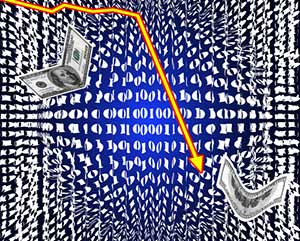Financials pulled a world-class fakeout last week, and that's important for what's coming next.
You see, on Thursday, markets looked like they were giving up; the major indexes broke through near-term support, and some important psychological support levels were pierced.
The breaking news was that China's exports had fallen 10%. So industrials, materials, and commodities took the brunt of the selling. China is always a barometer of global growth, because it does lots of the globe's growing. And so with news of China's export fall-off, financials were set to release their earnings amid an "atmosphere of reduced expectations," to put it mildly.
Of course, those expectations have been carefully stage-managed and downplayed all along - there's that psychology again.
Then on Friday, starting with JPMorgan Chase & Co. (NYSE: JPM) before the open, the banks let fly with their earnings, and things got "interesting"...
Robots and Cooperative Analysts Set Up This Profit Play
 Banks are under stress worldwide, of course, but especially in Europe. Here in the United States, earnings are weak, and so banks have taken it on the chin. Thursday was no exception.
Banks are under stress worldwide, of course, but especially in Europe. Here in the United States, earnings are weak, and so banks have taken it on the chin. Thursday was no exception.
Of course when the volume dried up, the "robots" - high-frequency trading (HFT) computers - took over. The robots were trying to show bids to scare shorts into covering and entice buyers into the game.
It worked, as it usually does. Because that's what runs markets these days in the absence of committed investor moves: robotic, high-frequency trading.
As a matter of fact, nine times out of 10, HFT will reverse whatever sizable, knee-jerk moves that mere human traders precipitate, as they did when that support level was cracked on Thursday.
You see, the 'bots can almost instantly ascertain the best risk/reward moves to make on an extremely short-term basis. I know, because I've designed HFT algorithms, or "algos," as they're called.
So after a soft landing of sorts, courtesy of Thursday's HFT action, the financials' "main event" started on Friday. For entertainment, they didn't disappoint.
Well... at least JPMorgan Chase didn't disappoint. In fact, JPMorgan's "better than expected earnings," which came out well before the open, moved all the financials higher in pre-market trading and boosted the futures substantially higher.
Then Well Fargo & Co.'s (NYSE: WFC) earnings numbers came out, then Citigroup Inc.'s (NYSE: C). They, too, beat analysts' expectations, and the market moved higher, dancing to the rising tide of the financials.
Now, this might represent fundamentally good news if their reports were based on anything resembling reality - fuzzy earnings reporting, analysts who obligingly lower the bar for earnings and revenue expectations, global central bank activity, money market reforms, and even Brexit have given banks a leg up.
The reality is, return on equity (ROE) has fallen for each of the three giants that reported on Friday. Citigroup is the weakest link of the bunch, with its rotten 6.8% ROE this quarter and slippage in the value of assets it's hiding in its bad bank division.
None of these banks are screaming buys right now, and there's nothing in these earnings worth celebrating...
[mmpazkzone name="in-story" network="9794" site="307044" id="137008" type="4"]
...Unless you're short banks. That's where the money is in this setup. Of the three banks that declared Friday, JPMorgan makes the most compelling short. Its 52-week high is just over $69, and with things as they are now, it's unlikely to beat that. This short is an excellent risk vs. reward play right now, just make sure you set a hard stop at $70 in the (extremely) unlikely event that things change and the stock attempts those heights.
I think these banks are going to have lots of company chasing highs that won't come...
Where We Will (or, More Likely, Won't) Go from Here
Now, anything could happen, but the likelihood of sidelined money suddenly finding the courage to come pouring into stocks is pretty low.
There's just too much going on right now...
Investors and taxpayers in the United States are worried about the presidential election, while investors and taxpayers in Europe are sweating whether they'll have to backstop their own banks. Investors are sick and tired of falling earnings, and macro-global pressures are as high as they ever were.
The tide of global stimulus funny money was supposed to lift all boats... not just stock prices... but we're treading water in the deep end of the pool - and facing the specter of broken support, no less.
Like I said, "it" could happen, but we'd have to have a lot of positives to give us the tailwind we need to get really airborne.
I'm not keen on adding new positions right now, unless I see a trade I just can't pass up, like shorting JPMorgan. I'm going to stick to discipline and watch the stock market go sideways for a while... until it doesn't.
I'll let you know if anything changes.
Most analysts lock down their screens tighter than Fort Knox. But when you can track an abundance of gains like this… every single day the market is open… all from a simple trade anyone can enter… there’s no reason to be secretive anymore. Click here to open a video session.
Follow Shah on Facebook and Twitter.
About the Author
Shah Gilani boasts a financial pedigree unlike any other. He ran his first hedge fund in 1982 from his seat on the floor of the Chicago Board of Options Exchange. When options on the Standard & Poor's 100 began trading on March 11, 1983, Shah worked in "the pit" as a market maker.
The work he did laid the foundation for what would later become the VIX - to this day one of the most widely used indicators worldwide. After leaving Chicago to run the futures and options division of the British banking giant Lloyd's TSB, Shah moved up to Roosevelt & Cross Inc., an old-line New York boutique firm. There he originated and ran a packaged fixed-income trading desk, and established that company's "listed" and OTC trading desks.
Shah founded a second hedge fund in 1999, which he ran until 2003.
Shah's vast network of contacts includes the biggest players on Wall Street and in international finance. These contacts give him the real story - when others only get what the investment banks want them to see.
Today, as editor of Hyperdrive Portfolio, Shah presents his legion of subscribers with massive profit opportunities that result from paradigm shifts in the way we work, play, and live.
Shah is a frequent guest on CNBC, Forbes, and MarketWatch, and you can catch him every week on Fox Business's Varney & Co.



